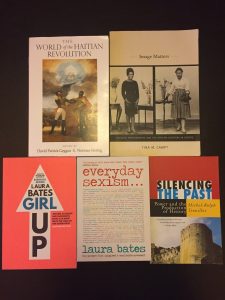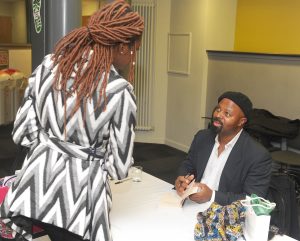“National Non-Fiction November is the Federation of Children’s Book Groups’ annual celebration of all things factual.” – FCBG
I have always had a soft spot for non-fiction, which was definitely born out of my love of history, and I was excited to learn about a month dedicated to encouraging children and adults to read non-fiction books and celebrate with those who already love them.
With this celebration in mind I stood in front of my ‘non-fiction bookshelf’ (which in reality is half non-fiction and half graphic novels/comic books/miscellaneous) to choose five of my favourites. I want to share these reccomendations with you in the hopes of encouraging the flow of information and the love of non-fiction.
Everyday Sexism by Laura Bates
Everyday Sexism is an exploration into the ever present sexism that women experience daily, from ‘small’ acts of verbal harassment to the horrifying experiences of sexual assault. Laura Bates combines statistics with real experiences shared on her Twitter feed and the Everyday Sexism website.
Its blurb describes it as “Bold, jaunty but always intelligent [… a] protest against inequality that provides a unique window into the vibrant movement sparked by this juggernaut of stories – often shocking, sometimes amusing and always poignant.” At times it is difficult to read, specifically regarding the stories of assult, but does offer a glaring insight into the often frightening experiences that women face when they walk outside their front door.
Girl Up by Laura Bates
Another one by Laura Bates (I think I’m in love with her). Girl Up is aimed at teenage girls and young women. Emma Watson praises the book by saying it “unapologetically addresses what teenage girls are really dealing with.” It covers everything from the hypocrisy of dress codes to consent. This book does not hold back – there are swear words and non-censored sex education – but it is also an engaging read that I wish existed when I was a teenager.
Silencing the Past: Power and the Production of History by Michel-Rolph Trouillot
Now onto my love of History (and my issues with it). Silencing the Past is a wonderful little book (191 pages) that tackles the idea that power dictates history and explores what history is deemed important (spoiler alert: white, western history). It explores (with its limited length) some histories that have been ‘silenced’, specifically it covers the Haitian slave revolt, the denials of the Holocaust, and the debate over the Alamo. This book is an interesting look at the role power plays in the recording of history.
The World of the Haitian Revolution edited by David Patrick Geggus & Norman Fiering
The World of the Haitian Revolution is a collection of essays that attempts (quite successfully) to explore the complex issues surrounding Haiti’s emancipation from the French Empire. This collection covers everything from Haiti (formally known as Saint-Domingue) before the French Revolution, to its own revolution and the creation of the first independent black nation.
A truly fascinating period of History that is often forgotten about and is dear to my heart as Haiti (along with Guadeloupe and Martinique) was the subject of my undergraduate dissertation. It is therefore a subject I will gladly talk (read: rant) about for hours.
Image Matters: Archive, Photography, and the African Diaspora in Europe by Tina M. Campt
Image Matters is a look into African diaspora in Europe through a collection of two photographic archives explored and analysed by Tina M. Campt. The first collection is of black German families taken between 1900 and 1945 and the second are studio portraits of West Indian migrants living in Birmingham, England taken between 1948 and 1960.
Elizabeth Edwards describes how this book explores “questions about the nature of historical evidence and the historical process.” It is facinating look into race and class in 20th century Europe, filled with photographs that tell stories about people who history often ignores.
—
You can find out more about Non-Fiction November 2016 here. Happy reading.
by Alice Laing






 Who would have ever thought that one of the most prestigious British book awards may be given according to one, simple criteria: “the best novel in the opinion of the judges”? The uniqueness of the Man Booker Prize lies also in the jury which is not (as someone would predict) contained only of literary critics or professors of literature – but also readers reflecting multiple backgrounds: politicians, actors or journalists. Honesty and simplicity that is expressed in this prize seem convincing even for me, a rebel always skeptical to the tastes of highly regarded authorities. And it must mean something.
Who would have ever thought that one of the most prestigious British book awards may be given according to one, simple criteria: “the best novel in the opinion of the judges”? The uniqueness of the Man Booker Prize lies also in the jury which is not (as someone would predict) contained only of literary critics or professors of literature – but also readers reflecting multiple backgrounds: politicians, actors or journalists. Honesty and simplicity that is expressed in this prize seem convincing even for me, a rebel always skeptical to the tastes of highly regarded authorities. And it must mean something. Mention the name Hodder Gibson to anyone who was educated in Scotland and there are immediate flashbacks to countless hours spent revising with their past papers. So when Peter Dennis, Managing Director at Hodder Gibson arrived on Thursday afternoon, it was like a blast from the past for many of us.
Mention the name Hodder Gibson to anyone who was educated in Scotland and there are immediate flashbacks to countless hours spent revising with their past papers. So when Peter Dennis, Managing Director at Hodder Gibson arrived on Thursday afternoon, it was like a blast from the past for many of us.





